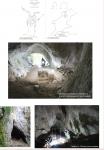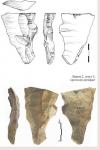Summary (English)
ARCHAEOLOGICAL EXPLORATIONS NEAR THE VILLAGE OF MLADEZHKO (Stefanka Ivanova – ivanova.stefanka@gmail.com, Maria Gurova) The Leyarnite cave complex include four caves formed in marbleized limestone and situated at c. 25 m above the Tamna Reka River. The Leyarna 2 Cave is 23 m long, 6 m wide and 3 – 8 m high. Sherds from the Chalcolithic period, the Bronze and the Iron Ages and the Middle Ages were found on the floor of the cave. A sondage was carried out and the depth of 1.60 m was reached. Five lithostratigraphic units were documented. Sherds and animal bones were found in layer 1. Bones from Late Pleistocene mammals and an Upper Paleolithic flint fragment from a core for producing plates were found in layer 3. Bones from Pleistocene animals and a Middle Paleolithic flint fragment, probably originating from a core, were found in layer 4. The two flint artifacts are the first archaeological proof for human occupation in the region during the Middle and the Upper Paleolithic periods. The Leyarna 4 Cave is 23 m long, 7 m wide and 13 m high. A sondage was carried out and the depth of 3.67 m was reached. Eight lithostratigraphic units were documented. Layer 1 contained traces from the Iron Age, the Hellenistic period and the Middle Ages. Layers 3 – 8 had Pleistocene features. No archaeological material was found. The Late Pleistocene fauna assemblage included Equus cf. germanicus transilvanicus, Crocuta spelaea, Ursus spelaeus, Capra ibex, Cuon, Bufo bones, Vulpes vulpes, Lepus, Mesocricetus newtoni, Eolagurus luteus, Terricola subterraneus, Microtus arvalis – agrestis, and Chionomys nivalis. The fauna assemblage indicated that during the colder periods of the Pleistocene, the climate in the region of the Strandzha Mountain was relatively mild and humid.
- Stefanka Ivanova - Archaeolgical Isnstitute with Museum
- Maria Gurova - Archaeological Institute with Museum
Director
Team
Research Body
- Archaeological Institute with Museum






![Download [PDF]](/excavation/skins/fasti/images/results/download_sml.png)
